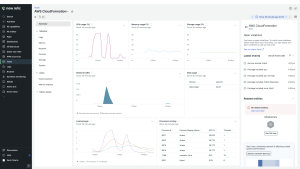What is serverless architecture?
Serverless architecture is a cloud computing approach where developers build applications without managing server infrastructure, as the cloud provider handles provisioning and scaling resources. The system runs code in response to events and only charges for the compute time consumed during execution, so it can easily scale based on demand. While servers do still exist in this paradigm, the name derives from the fact that server management responsibilities are largely abstracted away from application developers so they can focus on business logic rather than infrastructure.
How serverless architecture works
With a serverless infrastructure, developers deploy code as individual functions that execute in stateless containers managed by the cloud provider. When an event occurs—such an HTTP request, database change, file upload, or scheduled trigger—the cloud provider automatically provisions the necessary computing resources to run the function, executes the code, and then releases the resources when processing completes. The execution environment scales instantly from zero to whatever capacity is needed to handle incoming requests, with users paying only for the precise computing time and memory consumed during function execution. Modern serverless computing generally includes function execution environments, API gateways for routing requests, backend storage services, and event sources that trigger function execution.
Decomposing drives better observability
With serverless, you break down applications into smaller and smaller pieces, known as decomposition. By doing so, you’ll gain better observability across the application.
With smaller pieces, the knowledge necessary to make changes or create fixes is smaller.
Serverless is event-based
Serverless uses an event-based system versus stream-based. With event-based architecture, each subpart of the application is independent. Events trigger one another. In stream-based, there are connections to each service. If there is a failure, it just impacts that event, not the entire log.
Faster time to release
Speed is often a contributing factor in choosing to use a serverless architecture. You can rapidly deploy apps in hours because there’s no infrastructure construction to weigh you down. With faster deployments also comes ease in scalability.
By using such an agile architecture, you can be very flexible in your releases. Because it’s a quicker process, you can accelerate innovation.
This flexibility is especially valuable in situations where pivoting is urgent. These types of scenarios are playing out all over the world in response to the pandemic. Organizations have to change their focus to meet emerging needs. This could be internal with a move to remote work. Another example is the adoption of customer-facing applications like those of retailers and restaurants.
Cost
Being serverless, an organization is essentially outsourcing server and database management. You are no longer responsible for the huge investments required for internal architecture administration. Ultimately your use case will define how much you can save.
Focusing more on UX
If your applications have end users, which they probably do, they have high expectations around digital experiences. If architecture is no longer a concern, it leaves more time to work on the user experience (UX). You can’t afford to not invest in the user interface, so serverless can provide you with a way to reallocate resources.
Scalability
Serverless applications automatically adjust computing resources in real-time based on actual demand, eliminating the traditional challenge of capacity planning. When traffic increases, the cloud provider instantly provisions additional resources to handle the load without any manual intervention or configuration changes from developers. This elastic scaling works in both directions: spinning up resources during usage spikes and scaling down to zero during periods of inactivity. The result is a highly responsive system that maintains consistent performance regardless of fluctuating workloads, freeing development teams from the complex task of predicting and provisioning for peak demand scenarios.
What are the limitations of using serverless architecture?
Serverless architecture isn’t perfect. It’s still an evolving architecture, leaving some not ready to adopt.
Long-running application inefficiencies
Running workloads, which are long-running, could be more costly on serverless. Using a dedicated server is often more efficient.
Limited Control
Serverless architecture requires you to be reliant on your provider. You don’t have full control, and changes may impact you without notice. The platform’s availability is subject to its terms.
Cold starts
A “cold start” occurs when a platform must initiate internal resources. It may take some time for your serverless architecture to handle that first function request. You can avoid a “cold start” by ensuring the function remains in an active state. You do this by sending requests to it periodically.
Debugging Complexity
Troubleshooting issues in serverless architecture presents unique challenges due to functions executing in ephemeral, distributed environments beyond direct developer control. Traditional debugging techniques often fail as functions run in short-lived instances without persistent state, making it difficult to replicate problems or trace execution paths across multiple serverless components. This complexity requires specialized monitoring solutions designed specifically for serverless environments to effectively identify and resolve performance issues.
What is the difference between microservices and serverless architecture
When it comes to structuring modern applications, the decision between serverless and microservices architectures isn't necessarily a binary choice. Rather than viewing them as mutually exclusive, it's productive to recognize how they can complement each other. Serverless architecture can serve as the ideal hosting environment for microservices, providing automatic scaling, high availability, and a pay-as-you-go model that aligns with the microservices philosophy of efficiency and agility.
On the other hand, microservices allow for modular development and deployment, which can be enhanced by the serverless model to ensure that each service is independently scalable and maintainable. Integrating serverless technology with a microservices design enables teams to focus on developing robust, discrete functionalities while outsourcing the operational concerns of running servers. This leads to a harmonious blend of the two approaches that capitalize on their individual strengths to build resilient, cost-effective, and future-proof digital solutions.
Serverless architecture use cases
The flexibility and scalability of serverless computing make it suitable for a wide range of applications across different industries. However, there are particular application use cases where the nature of a serverless architecture has some advantages.
- Web applications and microservices: Serverless functions act as discrete, independently scalable components, offering more granular control and easier management compared to monolithic server setups
- APIs and backend services: Instead of provisioning and managing server capacity, serverless functions effortlessly scale to meet API demand, providing a responsive and cost-effective backend solution.
- Data processing and transformation: Data operations become more responsive with serverless, which activates on events or schedules, eliminating the delays and inefficiencies associated with persistent server-based processing.
- Real-time file processing: Serverless architecture shines in automatically executing file transformations immediately upon upload, bypassing the need for dedicated servers that would otherwise be waiting for tasks.
- Chatbots and virtual assistants: By dynamically allocating resources based on user interaction volume, serverless ensures chatbot responsiveness without the complexity and cost of server scaling.
- Authentication and authorization: Serverless functions provide a lightweight, maintainable method for user authentication, circumventing the constant resource consumption of traditional authentication servers.
- Scheduled tasks and batch jobs: Serverless excels in executing scheduled tasks with precision and without the need for a permanent server presence, reducing both resource waste and operational costs.
- Prototyping and rapid development: Developers can use a serverless architecture to develop experimental code without worrying about provisioning server capacity, allowing them to quickly test and validate new ideas with less operations overhead.
Is serverless architecture for you?
Serverless architecture is just one more option for deploying applications in the cloud. Serverless shines in scenarios where applications are event-driven and have components that run in short, sporadic bursts, ensuring you only pay for the compute time you use rather than for idle server space. This can lead to significant cost savings for functions that don't need the continuous execution of a traditional server. For workloads that experience variable traffic—such as those driven by promotional events, viral content, or seasonal usage spikes—serverless architecture can effortlessly and instantly scale up to handle surges and then scale back down to minimize costs when demand decreases.
However, it’s not a one-size-fits-all solution. While there are advantages to serverless vs. other architectures, the differences also bring new challenges to development & operations that need consideration. To keep them performing as efficiently as possible, you need new techniques to monitor and troubleshoot issues with serverless architectures. Explore how we make this possible with New Relic Serverless for AWS Lambda.
What is the best architecture for serverless?
For many use cases, Function-as-a-Service (FaaS) stands as the optimal serverless architecture pattern thanks to its event-triggered execution model and granular scaling capabilities. FaaS excels by executing discrete code functions in response to specific events, automatically scaling from zero to thousands of instances within seconds, and charging users only for actual compute time used rather than idle capacity. This architecture removes all server management concerns from developers while delivering maximum resource efficiency and cost optimization for organizations deploying serverless solutions.
Alternatives to consider include:
- API-driven serverless architecture, which combines API gateways with serverless functions to create robust, scalable endpoints without managing servers.
- Stream processing serverless architecture, which processes data streams in real-time using event-driven functions that automatically scale with data volume.
Étapes suivantes
Despite the automated nature of serverless, optimizing performance still requires comprehensive visibility into function execution, resource consumption, and error rates across your application ecosystem.
New Relic’s specialized serverless monitoring solutions provide real-time insights into function latency, cold starts, and error patterns while correlating serverless performance with downstream dependencies like databases and third-party APIs. These monitoring capabilities allow development teams to quickly identify bottlenecks, optimize resource allocations, and ensure cost-efficient scaling without sacrificing user experience.
Implementing proper observability from the beginning enables organizations to fully realize serverless benefits while maintaining control over performance and costs. Explore New Relic’s serverless monitoring platform and contact us today to learn how it can transform your cloud-native applications.
Les opinions exprimées sur ce blog sont celles de l'auteur et ne reflètent pas nécessairement celles de New Relic. Toutes les solutions proposées par l'auteur sont spécifiques à l'environnement et ne font pas partie des solutions commerciales ou du support proposés par New Relic. Veuillez nous rejoindre exclusivement sur l'Explorers Hub (discuss.newrelic.com) pour toute question et assistance concernant cet article de blog. Ce blog peut contenir des liens vers du contenu de sites tiers. En fournissant de tels liens, New Relic n'adopte, ne garantit, n'approuve ou n'approuve pas les informations, vues ou produits disponibles sur ces sites.




